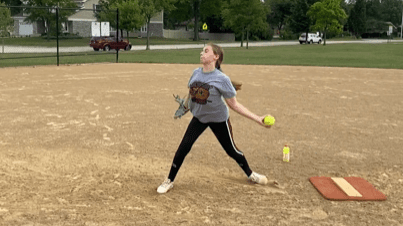Drill for Learning the Riseball Spin

The riseball has been called the “scholarship pitch.” And for good reason.
Despite the fact that it doesn’t really break upward as it approaches the hitter (despite what you may have heard on TV) a well-thrown riseball often gives the illusion of doing so. It’s all about how our brains perceive the information they’re receiving – just as there are no dots in the grid below even though it appears there are.
The key to the riseball illusion is the backspin. The more you can achieve a 12-6 spin, i.e., the ball spinning from the bottom to the top as it approaches the hitter (versus a standard fastball or drop ball which spins from the top to the bottom) the better it works.
(Of course, being able to throw it 70 mph makes the direction of the spin less important, but that’s a story for another day.)
The challenge many pitchers face when they first start learning the riseball is that getting your hand into the proper position to throw it is not that easy. It’s a significant change, in fact, from the foundational mechanics most pitchers learn.
As I’ve posted many times, the best way to throw the fastball/drop ball is to keep the inside of the forearm facing toward first base with the fingers pointing down, then release it as the forearm and hand pronate inwards. But even if you’re a “hello elbow”-type pitcher, your fingers will be pointed down at release; you’re just doing it earlier than you should.
With a riseball, to achieve backspin you need to have your hand cupped under the ball, i.e., pointed toward third base. And you need to do that before getting to release so you’re not trying to bring the fingers up at the same time you’re trying to release the ball, which would create top-to-bottom, bullet/gyro or some other less-than-desirable spin.
Getting cupped under at the right time allows the ball to be released over the back thumb with a slicing motion. Yet getting to that position can be difficult as it is a different movement pattern than pitchers, especially younger ones, are used to.
Facing that issue myself, I came up with an idea to help pitchers feel the hand/wrist position better. You can see it here in the video.
Regular readers know I’m a fan of using walls, constraints and other things to create a more tactile experience for pitchers. You can say “get your hand under the ball” until you’re blue in the face, but if it’s not connecting you need to try something else.
Of course, the proof is in the pudding. After a couple of minutes of slowly tracing the fingers on the wall, we went back to spinning an actual ball.
And whaddya know? It worked!
It wasn’t perfect every time, but whereas before she was getting top spin or bullet spin now she was starting to achieve backspin more often than not. Not bad for a few minutes’ work.
So if your pitcher is having trouble getting the hang of spinning the ball backwards give this a try. Hopefully you can get a breakthrough as well.
Posted on January 22, 2021, in Pitching and tagged backspin, cupping under, pitching drills, riseball. Bookmark the permalink. Leave a comment.





Leave a comment
Comments 0